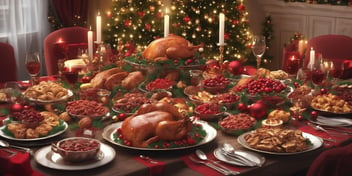- Blog
- Christmas questions
- How do people handle food allergies and dietary restrictions during Christmas feasts?

With Christmas just around the corner, the festive cheer is in full swing, and so are the dinner party preparations! Mouthwatering aromas waft through the air as we envision indulging in our favorite yuletide dishes. But amidst the joyful anticipation, many individuals find themselves navigating the tricky waters of food allergies and dietary restrictions during this culinary extravaganza.
Fret not, for we have gathered some insightful tips and tricks on how to navigate this deliciously challenging terrain, ensuring that everyone can feast to their heart's delight, without compromising their well-being. So, let's explore how people acrobatically handle food allergies and dietary restrictions during the grand Christmas feast!
Understanding Food Allergies and Dietary Restrictions
- Awareness of food allergies and dietary restrictions is important in creating an inclusive Christmas feast.
- Food allergies can range from common allergens like wheat and nuts to dairy and seafood.
- Dietary restrictions may include gluten-free, nut-free, dairy-free, or vegetarian/vegan choices.
- Knowing the specific allergens and restrictions helps in planning a menu that caters to everyone.
- Consider using alternative ingredients or substitutes to accommodate various dietary needs.
- For example, gluten-free alternatives like quinoa or rice flour can be used instead of wheat flour.
- Providing a variety of options ensures that guests with allergies and restrictions can enjoy the festive meal without worry.
Importance of Addressing Food Allergies and Dietary Restrictions
Addressing food allergies and dietary restrictions during Christmas festivities is an important aspect of ensuring inclusivity and the well-being of all guests. By taking these considerations seriously, hosts can create a welcoming atmosphere where everyone feels comfortable and accommodated. Failure to address these needs may lead to individuals feeling excluded or even facing health risks.
For example, offering alternative ingredients or dishes that cater to different dietary needs allows guests with allergies or restrictions to fully participate in the celebration. By proactively addressing these challenges, hosts can foster an enjoyable and inclusive Christmas gathering for all.
Preparing a Festive Menu
Identifying Common Christmas Allergens
Christmas feasts can introduce a range of allergens that could pose risks to certain individuals. Some commonly encountered allergens during this festive season include wheat and gluten, nuts and tree nuts, dairy and lactose, and seafood. These ingredients are often found in traditional dishes like cakes, cookies, and festive roasts. To accommodate guests with dietary restrictions, it's crucial to carefully read ingredient labels and ensure that potential allergens are clearly identified. By understanding what allergens are commonly present in Christmas dishes, hosts can take the necessary precautions to provide safe and inclusive options for all their guests.
Wheat and Gluten
Wheat and gluten are common allergens that can pose challenges during Christmas feasts. Here's how to handle them effectively:
- Offer gluten-free alternatives for traditional dishes like bread, stuffing, and desserts.
- Use gluten-free flours, such as almond or rice flour, when baking holiday treats.
- Incorporate naturally gluten-free ingredients like potatoes, rice, and vegetables into your menu.
- Clearly label dishes that contain wheat or gluten, and separate them from gluten-free options to avoid cross-contamination.
- Communicate with guests to ensure their specific dietary needs are met, and encourage them to bring gluten-free alternatives if necessary.
Nuts and Tree Nuts
Nuts and tree nuts are common allergens that can pose challenges during Christmas feasts. To accommodate guests with these allergies, it's important to be mindful of their presence in various dishes. Substitute ingredients like almond flour with alternatives such as gluten-free flours or coconut flour. Instead of using traditional nut toppings, consider options like toasted seeds or dried fruit for added texture and flavor.
When preparing desserts, experiment with recipes that use crushed cookies, oats, or seeds instead of nuts. By being aware of these alternatives and using them creatively, you can ensure that everyone can enjoy a delicious and safe Christmas meal.
Dairy and Lactose
In the context of "Christmas questions," dairy and lactose allergies or restrictions can pose challenges during festive feasts. Here are a few considerations:
- Opt for dairy-free alternatives like almond milk, coconut milk, or oat milk for cooking and baking.
- Use dairy-free spreads or margarine instead of butter in recipes.
- Prepare dairy-free desserts such as fruit platters, sorbets, or dairy-free chocolate treats.
- Offer non-dairy options like coconut-based whipped cream or plant-based cheese alternatives.
- Ensure that dishes containing dairy are clearly labeled to inform guests with lactose intolerance.
By providing dairy-free alternatives and clearly labeling dishes, you can accommodate individuals with dairy and lactose restrictions during Christmas celebrations.
Seafood
Seafood is commonly found in Christmas feasts, but it can pose challenges for individuals with allergies or dietary restrictions. Some people may be allergic to shellfish or have a seafood intolerance. To accommodate these guests, it is important to offer alternative options that are free from seafood contamination.
For example, roasted vegetables, vegetarian stuffing, or plant-based protein dishes can be excellent alternatives that everyone can enjoy.
Additionally, ensuring separate cooking utensils and avoiding cross-contamination during food preparation is vital to prevent allergic reactions. By being mindful of seafood allergies and offering suitable alternatives, you can create a inclusive and enjoyable Christmas feast for all.
Substituting Ingredients to Accommodate Allergies and Restrictions
When it comes to addressing food allergies and dietary restrictions during Christmas feasts, substituting ingredients is an effective way to cater to everyone's needs. For gluten allergies, consider alternative flours like rice flour or almond flour when baking. Replace cow's milk in recipes with plant-based milks such as almond or oat milk for those with lactose intolerance. Peanut and tree nut allergies can be managed by using sunflower seed butter or soy nut butter in recipes. And for vegan or vegetarian guests, opt for plant-based proteins like tofu or tempeh instead of meat. These ingredient swaps ensure that everyone can enjoy the festive meal without compromising their health or dietary restrictions.
Gluten-Free Alternatives
When it comes to gluten-free alternatives for Christmas feasts, there are plenty of options available. Instead of using traditional wheat-based flours, you can opt for alternatives like almond flour, coconut flour, or a gluten-free baking mix. These alternatives can be used to make delicious treats such as gluten-free cookies or cakes.
Additionally, there are gluten-free bread options available for holiday stuffing or as a base for canapés. Don't forget to check labels and ensure that all ingredients used are gluten-free. With a bit of creativity and experimentation, you can create a festive menu that accommodates gluten-free individuals without compromising on taste or variety.
Nut-Free Options
When catering to individuals with nut allergies during Christmas feasts, it's important to provide safe and delicious alternatives. Opt for recipes that use seeds like sunflower or pumpkin instead of nuts. For example, consider offering a seed-based granola as a topping for yogurt or a crunchy coating for chicken. In baked goods, swap almond flour with alternatives like oat or rice flour. Get creative with spreads and dips by using roasted vegetables or beans instead of the usual nut-based ones. By incorporating these nut-free options into your menu, you can ensure that everyone can enjoy the festive feast without compromising their health.
Dairy-Free Substitutes
Dairy-free substitutes are increasingly in demand during Christmas feasts. There are plenty of options available to replace dairy products with plant-based alternatives.
For example, almond milk, coconut milk, and oat milk can be used as dairy-free alternatives for beverages, sauces, and desserts. Nutritional yeast can be used as a flavorful substitute for cheese in various dishes.
Additionally, vegan butter or coconut oil can replace dairy butter in recipes. These alternatives not only cater to individuals with dairy allergies or lactose intolerance but also provide options for those following a vegan or plant-based diet. Experimenting with dairy-free substitutes can lead to delicious and inclusive Christmas meals.
Vegan and Vegetarian Choices
Vegan and vegetarian choices are common considerations when addressing dietary restrictions during Christmas feasts. Here are some tips for providing options:
- Offer a variety of plant-based dishes such as roasted vegetables, stuffed mushrooms, or lentil-based salads.
- Experiment with meat substitutes like tofu, tempeh, or seitan for traditional festive recipes like "meat"loaf or shepherd's pie.
- Incorporate flavorful herbs, spices, and seasonings to enhance the taste of vegetable-based dishes.
- Provide alternative protein sources like nuts, legumes, and quinoa to ensure balanced meals.
- Offer vegan-friendly desserts such as fruit platters, dairy-free cakes, or dark chocolate treats.
- Consider serving vegan and vegetarian dishes as side options to accommodate diverse preferences.
Remember to label these dishes clearly to assist guests in identifying suitable choices.
Including Everyone in the Menu Planning
To ensure everyone feels included in the Christmas menu planning, it's important to actively involve guests with dietary restrictions or allergies. Start by sending out a thoughtful email or making a phone call to gather information about their specific needs. Ask them for suggestions or recipes that fit their restrictions, and consider incorporating those into the menu.
Additionally, provide a variety of options that cater to different dietary preferences, such as gluten-free, nut-free, and vegan dishes. This way, everyone can find something suitable and enjoy the festive feast together.
Effective Communication
Informing Guests in Advance
Informing guests in advance about any food allergies or dietary restrictions they may have is an important aspect of creating an inclusive Christmas feast. By doing so, hosts can ensure that there are suitable menu options available for everyone. It allows guests with specific requirements to feel valued and accommodated. One way to inform guests is by sending out invitations with a note requesting them to communicate any allergies or restrictions.
Additionally, hosts can follow up with a phone call or email to gather specific details. This proactive approach helps in planning the menu and making necessary adjustments to avoid any potential issues during the festive gathering.
Labeling Dishes Clearly
Labeling dishes clearly is an important step when accommodating food allergies and dietary restrictions during Christmas feasts. By providing clear labels, guests can easily identify which dishes are safe for them to consume. Use simple and concise labels that mention any potential allergens or restricted ingredients.
For example, if a dish contains gluten, label it as "Gluten-containing" or "Contains wheat."
Additionally, consider using color-coded labels or specific symbols to indicate common allergens like nuts or dairy. Providing clear labels helps prevent accidental consumption of allergens and ensures a safe and inclusive environment for all guests.
Encouraging Guests to Share their Dietary Restrictions
Encouraging guests to share their dietary restrictions is vital for creating an inclusive Christmas feast. By openly discussing their needs, you can accommodate their allergies or restrictions easily. Consider sending a friendly email or including a note on the invitation, inviting guests to inform you about their dietary requirements. This allows you to plan the menu accordingly and ensure that everyone has options they can enjoy.
For example, someone might have gluten intolerance or be vegan, and by knowing this in advance, you can prepare gluten-free dishes or offer plant-based alternatives. Open communication fosters a considerate and welcoming environment for all guests to enjoy a safe and satisfying meal.
Providing Options for Guests to Bring their Own Food
Providing options for guests to bring their own food can be a considerate approach for accommodating diverse dietary needs during Christmas feasts. By allowing guests to bring their own dishes, you create an inclusive environment where everyone can enjoy the celebration without feeling left out. It also takes some pressure off the host to cater to every specific restriction.
Communicate with your guests in advance and encourage them to notify you about any allergens or restrictions in their dish. This way, you can ensure that there are appropriate options available for everyone, while also allowing individuals to contribute to the feast in a way that aligns with their dietary needs.
Addressing Christmas Questions
How to Cater to Multiple Allergies and Restrictions?
--How to Cater to Multiple Allergies and Restrictions?--
When dealing with multiple allergies and dietary restrictions during Christmas festivities, it's important to ensure that everyone feels included and safe. Here are some practical tips to help navigate this:
- Gather information: Ask your guests about their specific allergies and dietary needs well in advance to plan accordingly.
- Customize dishes: Prepare a variety of dishes that cater to different requirements, such as gluten-free, nut-free, and vegan options.
- Separate preparation areas: Prevent cross-contamination by using separate utensils, cutting boards, and cookware for allergen-free dishes.
- Clear labeling: Clearly label each dish with its ingredients to help guests make informed choices.
- Buffet style: Opt for a self-serve buffet so guests can choose foods that suit their dietary restrictions.
- Communication is key: Encourage open communication with guests to answer questions and address any concerns they may have.
By taking these steps, you can create a festive environment where everyone can enjoy the Christmas feast without compromising their health or dietary needs.
Creating a Safe and Inclusive Festive Atmosphere
- Encourage open communication: Foster an environment where guests feel comfortable discussing their allergies and restrictions. Provide a platform for guests to share their dietary needs in advance.
- Designate food zones: Set up separate areas for allergen-free dishes to avoid cross-contamination. Clearly label these zones to ensure everyone is aware of the allergen-specific areas.
- Educate guests: Offer information about allergens and restrictions, ensuring everyone understands the potential risks and can make informed food choices.
- Serve a variety of options: Prepare diverse dishes that cater to different dietary needs, including vegan, gluten-free, and nut-free options. This guarantees that everyone can find something suitable to enjoy during the festivities.
- Be mindful of decoration: Check for any potential allergens in decorations like garlands or wreaths, ensuring they are safe for guests with allergies.
- Provide alternative activities: Consider hosting non-food-related activities, such as games or crafts, to create an inclusive atmosphere where the focus is not solely on food.
Finding Christmas Treats that Suit Everyone
Finding Christmas treats that suit everyone is an important aspect of catering to diverse dietary needs during the festive season. It can be challenging, but with a little creativity, it is possible to provide delicious options for everyone.
Consider offering a variety of allergen-free cookies, such as gluten-free sugar cookies or nut-free gingerbread. Similarly, create a fruit platter with a selection of different fruits to accommodate those with dietary restrictions.
Additionally, homemade treats with simple ingredients can be a great option. For example, dark chocolate-dipped strawberries or dairy-free coconut truffles can satisfy various preferences. Experimenting with flavors and textures will ensure there is something special for everyone to enjoy this Christmas.
Conclusion
The holiday season can be tricky for those with food allergies and dietary restrictions, but there are various ways people handle this during Christmas feasts. Many individuals proactively communicate their needs to hosts or bring their own meal to ensure their dietary restrictions are accommodated. Some choose to focus on the non-food aspects of the celebration and enjoy the social aspect while avoiding potential allergens.
Read On

Delicious Keto-Friendly Dishes for a Healthy Christmas Feast
Are you dreaming of a Christmas feast that is both delicious and healthy? Well, you're in luck...

Indulge in Gluttony: A Guide to Hosting a Christmas Eve Banquet
'Tis the season to unleash the inner epicurean within, as Christmas draws near, bringing with it an...

Indulgent Holiday Treats: Delicious Recipes to Satisfy Your Sweet Tooth
The holiday season is just around the corner, filling the air with a festive spirit and undeniable...